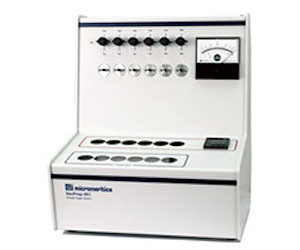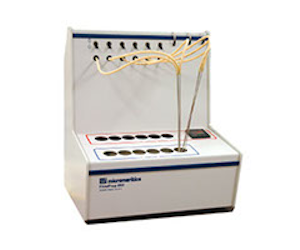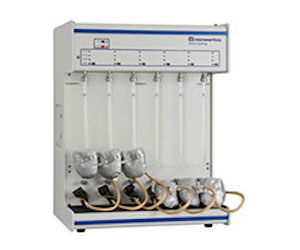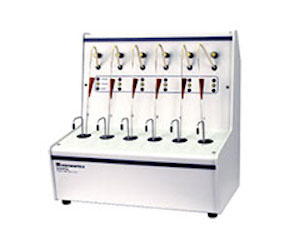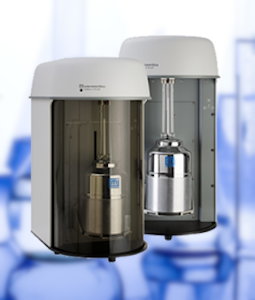
Tristar II 3030 Plus
High Throughput Surface Area and Porosity Analyzer
- ▪ Competitive cost
- ▪ Rapid and accurate measurement
- ▪ Fully automated analysis
- ▪ Ideal for high throughput sample analysis
- ▪ Long lasting dewar to accommodate longer analysis
- ▪ Krypton option for low surface area measurements
- ▪ High analysis versatility
- ▪ Enhanced data reduction
TriStar II Plus
Micromeritics' TriStar II Plus is a state-of-the-art instrument suited for use in both quality control and research environments. Intended for laboratories that require high throughput and the highest quality data, it contains all the capabilities of the TriStar II with additional hardware and software features.
Surface Area and Porosity Instrument
Analytical Versatility/ High Throughput/Small Footprint
The TriStar II Plus is a an automated, three-station, surface area and porosity analyzer that delivers excellent performance and speed of analysis. With three available analysis ports, the TriStar II Plus provides high sample through-put and advanced data analysis features to the user. The unique stainless steel analysis manifold is corrosive resistant and designed for highly accurate gas management for confident and repeatable results.
Advanced Hardware and Software Features
- The unique stainless steel analysis manifold is corrosive resistant and designed for highlyaccurate gas management
- Improved Dewar design provides more than 40 hours of continuous temperature control
- Intuitive MicroActive software gives the user the ability to interactively evaluate isotherm data and reduces the time required to obtain surface area and porosity results
- User-defined reporting options allow direct modeling
- Powerful Python scripting language allows users to develop extensions to the standard report library available within the TriStar II Plus software application
- An innovative dashboard monitors and provides convenient access to real-time instrument performance indicators and maintenance scheduling information
- Capable of utilizing two isotherms (CO2 and N2) for calculating pore size diameter via NLDFT for micropore analyses of carbons

Data Reduction Benefits
- Interaction with adsorption data is direct. By simply moving the calculation bars, the user is immediately updated with new textual properties. One-click access to important parameters allows the user to focus on the result rather than the parameters
- Interactive data manipulation minimizes the use of dialog boxes and tunneling of dialogs to specify calculation parameters. This allows the user to accurately and efficiently determine surface area and porosity of their materials
- Improved ability to overlay files (up to 25) including mercury intrusion data with a file add and subtract feature
- User selectable data ranges through the graphic interface allows direct modeling for BET, t-Plot, Langmuir, DFT interpretation, and much more
- Report Options editor allows the user to define up to five reports with on-screen previews. Each report has the ability to possess multiple summary, tabular, and graphical information panes
Low Surface Area Measurement Option
A Krypton Option can extend surface area measurements to as low as 0.001 m2/g.
Enhanced Software Capability & Instrument Monitoring
The intuitive MicroActive for TriStar II Plus software gives the user the ability to interactively evaluate isotherm data and reduce the time required to obtain surface area and porosity results. It is not necessary to generate reports to view results.
Calculations, such as the BET surface area transform plot, can be easily generated and adjusted. The selection bars allow for a range of data points to be quickly and easily selected. As a result, the summary of values derived from the calculations is instantly updated. Within the calculation window(s), the range of data used can be further refined.
The Dual DFT
Extended Pore Range Analysis
The Dual DFT NLDFT model allows the user to combine the information gathered from nitrogen and carbon dioxide isotherms to deliver a full pore size distribution on materials (such as carbon slit pores) where pores of molecular sizes are present. The range of pore size analysis in this method is extended to smaller pore sizes compared to the standard nitrogen analysis. This is due to the fact that CO2 can access some very small micropores that are not accessible to N2 at cryogenic temperatures due to size restrictions, connectivity problems, or extremely slow diffusion.
This advanced NLDFT method allows users to determine the pore size distribution of their sample using two isotherms. In this example CO2 adsorption (red) at 273 K and nitrogen adsorption (green) at 77 K are used to calculate a single pore size distribution. Users do not have to cut and paste distributions from CO2 and nitrogen - a single distribution is determined using both isotherms.

